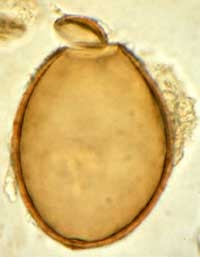Diseases linked to fish consumption
The surprise came when the analysis of human excrement, often preserved in archaeological layers in wet environments, revealed a very high number of intestinal parasites in the form of eggs. These eggs are proof of the frequency of serious parasitoses such as liver flukes (contracted from eating raw greens) and also bothriocephalosis, linked to the consumption of raw or undercooked fish. Nearly all the inhabitants of Chalain and Clairvaux seemed to be afflicted with this fish-related parasitosis; it causes severe anemia accompanied by cardiovascular problems and hemorrhaging.
Eggs of Diphyllobothrium sp.
Chalain 4, 31st century BCE.
Fishing out of the lakes
This discovery questions the idea that fishing was little practiced. Moreover, the study of fish bones shows that they were river trout. It seems that we are in the presence of agricultural populations who, though living on the shore of a lake, did not get their fish from it. Instead, they went where the fish were plentiful: in rivers where they are easy to catch by hand, by stretching nets across the river, or with hand nets.
In this way, the net found at Chalain 19 is a good illustration of this type of fishing. Fish, once caught, were not brought back whole to the village. Instead, care must have been taken to remove the flesh that would then be smoked and preserved, as it is suggested by the scarcity of fish bones in dwelling places, as well as the diseases linked to consumption of raw or undercooked fish.
Large framed fishing net, probably manipulated by hand.


